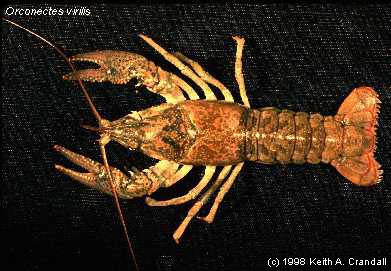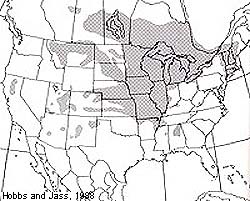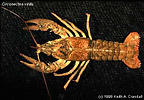Orconectes (Gremicambarus) virilis
Keith A. Crandall, James W. Fetzner, Jr., and Horton H. Hobbs, Jr.Types
Syntypes, Museum of Comparative Zoology, Harvard University, Cambridge, Massachusetts 194 (male I, male II, 4 female, 2 ovigerous female), Museum of Comparative Zoology, Harvard University, Cambridge, Massachusetts 196 (7 male I, 3 male II, 3 female, juv. male, juv. female), Museum of Comparative Zoology, Harvard University, Cambridge, Massachusetts 203 (male II, 3 female), Museum of Comparative Zoology, Harvard University, Cambridge, Massachusetts 1151 (male I), Museum of Comparative Zoology, Harvard University, Cambridge, Massachusetts 3342 (male I, 5 male II, female, 2 juv. male, jum. female), Museum of Comparative Zoology, Harvard University, Cambridge, Massachusetts 3343 (4 male I, female), Museum of Comparative Zoology, Harvard University, Cambridge, Massachusetts 3344 (male II, 2 female, juv. male, 3 juv. female), Museum National d'Histoire Naturelle, Paris, France, Wurzburg Museum, Wurzburg, Germany, Australian Museum, Sydney, Australia.Range
From Saskatchewan to Ontario, Canada, and from Montana and Utah to Arkansas, New York, and Maine. Introduced into California (Riegel, 1959:29, 37); Maryland (Meredith and Schwartz, 1960:28); parts of New England (Crocker, 1979:247; D.G. Smith, 1979:388); Alabama, Tennessee, Mississippi, and West Virginia (Bouchard, 1976a:583); Utah (Johnson, 1986:630); New York (Crocker, 1979:247); Chihuahua, Mexico (Campos and Contreras, 1985:218); and Pennsylvania (specimen in National Museum of Natural History from Adams County). See "Remarks" under O. (G.) causeyi.References
Bouchard, Raymond W. 1976. Geography and Ecology of Crayfishes of the Cumberland Plateau and Cumberland Mountains, Kentucky, Virginia, Tennessee, Georgia and Alabama, Part I: The Genera Procambarus and Orconectes. In James W. Avaolt, Jr., editor, Freshwater Crayfish, pages 563-584, 1 figure. Baton Rouge, Louisiana. Louisiana State University Division of Continuing Education.
Compos Gonzalez, Ernesto, and Salvador Contreras Balderas. 1985. First Record of Orconectes virilis (Hagen) (Decapoda, Cambaridae) from Mexico. Crustaceana, 49(2): 218-219.
Crocker, Denton W. 1979. The Crayfishes of New England. Proceedings of the Biological Society of Washington, 92(2): 225-253, figures 1-7.
Faxon, Walter. 1914. Notes on the Crayfishes in the United States National Museum and the Museum of Comparative Zoology with Descriptions of New Species and Subspecies to Which is Appended a Catalogue of the Known Species and Subspecies. Memoirs of the Museum of Comparative Zoology at Harvard College, 40(8): 351-427, 13 plates.
Hagen, Hermann A. 1870. Monograph of the North American Astacidae. In Illustrated Catalogue of the Museum of Comparative Zoology at Harvard College, 3: viii + 109 pages, 11 plates.
Hobbs, H. H. Jr. 1989. An Illustrated Checklist of the American Crayfishes (Decapoda: Astacidae, Cambaridae, and Parastacidae). Smithsonian Institution Press.
Johnson, James E. 1986. Inventory of Utah Crayfish with Notes on Current Distribution. Great Basin Naturalist, 46(4): 625-631, figure 1.
Meredith, W. G., and F. J. Schwartz. 1960. Maryland Crayfishes. Maryland Department of Research and Education, Educational Series, 46: 32 pages, figures 1-17.
Riegel, J.A. 1959. The Systematics and Distribution of Crayfishes in California. California Fish and Game, 45(1): 29-50, figure 1-10.
Smith, Douglas G. 1979. Variability of Crayfish of the Virilis Section (Cambaridae: Orconectes), Introduced into New England and Eastern New York. American Midland Naturalist, 102(2): 338-391, figure 1, 2.
Taylor, C. A., M. L. Warren, Jr., J. F. Fitzpatrick, Jr., H. H. Hobbs III, R. F. Jezerinac, W. L. Pflieger, and H. W. Robison. 1996. Conservation Status of Crayfishes of the United States and Canada. Fisheries 21:4.
Title Illustrations

Orconectes (Gremicambarus) virilis
Photo copyright © 1998 Keith A. Crandall
| Copyright |
© Keith A. Crandall

|
|---|
About This Page
Page constructed by Emily Browne.
Keith A. Crandall

Brigham Young University, Provo, Utah, USA
James W. Fetzner, Jr.

Carnegie Museum of Natural History, Pittsburgh, Pennsylvania, USA
Horton H. Hobbs, Jr.

Wittenberg University, Springfield, Ohio, USA
Correspondence regarding this page should be directed to Keith A. Crandall at
keith_crandall@byu.edu
Page copyright © 2001
All Rights Reserved.
Citing this page:
Crandall, Keith A., James W. Fetzner, Jr., and Horton H. Hobbs, Jr. 2001. Orconectes (Gremicambarus) virilis . Version 01 January 2001 (under construction). http://tolweb.org/Orconectes_%28Gremicambarus%29_virilis/7226/2001.01.01 in The Tree of Life Web Project, http://tolweb.org/









 Go to quick links
Go to quick search
Go to navigation for this section of the ToL site
Go to detailed links for the ToL site
Go to quick links
Go to quick search
Go to navigation for this section of the ToL site
Go to detailed links for the ToL site